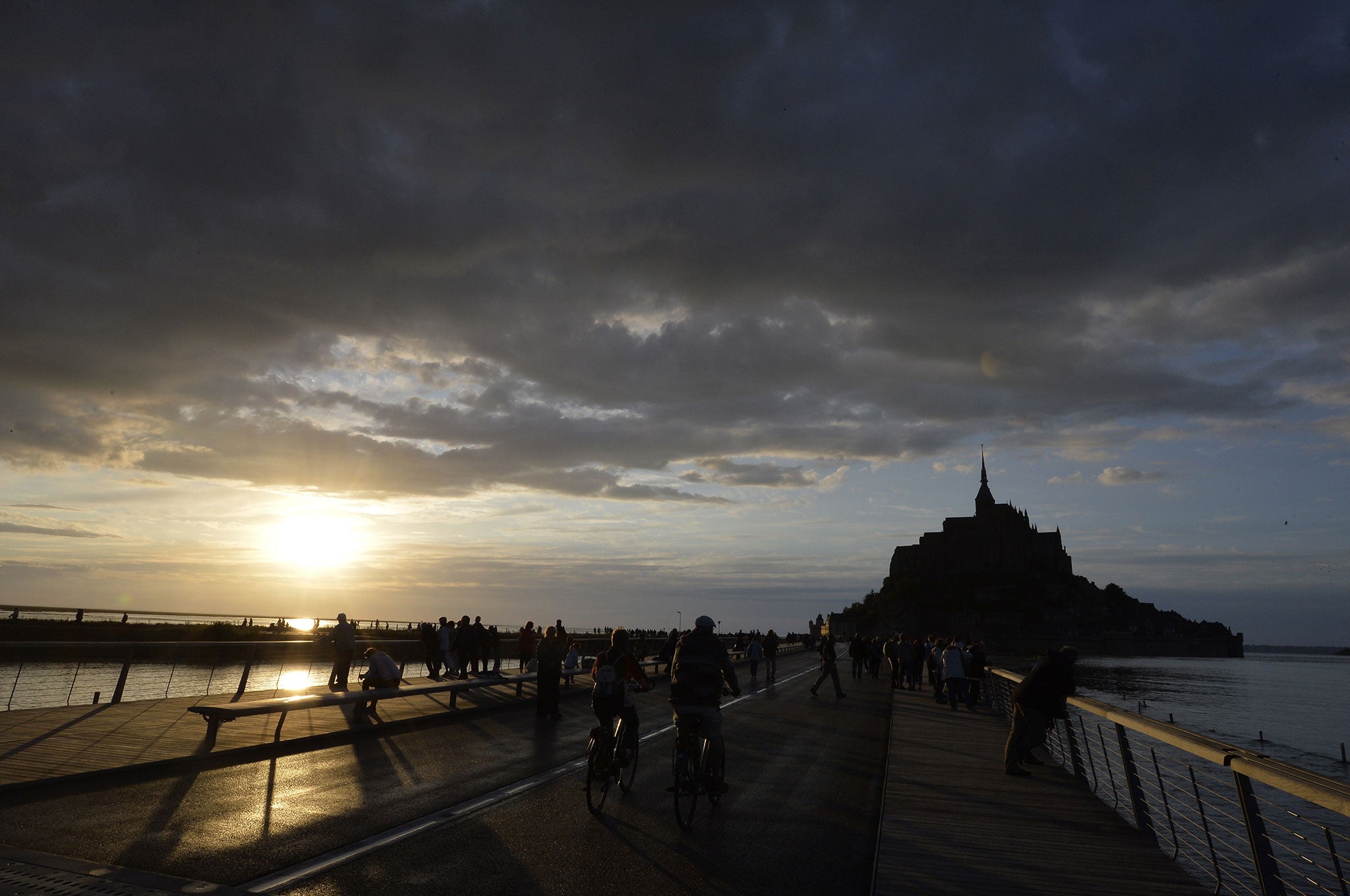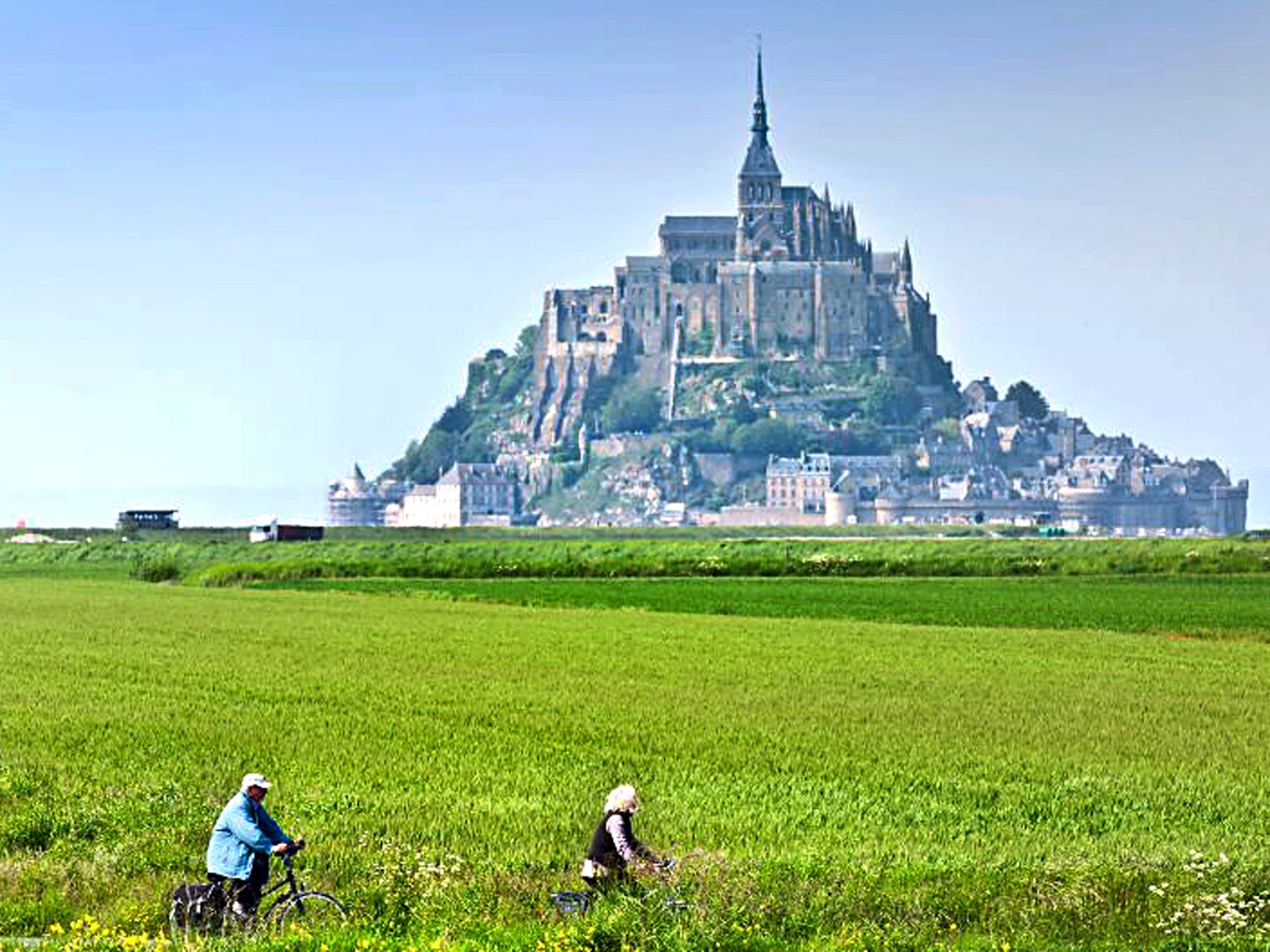French connection: After 1,300 years, there’s a bridge to Mont Saint-Michel
The ugly causeway is being dismantled, an elegant connection erected in its place. So everyone’s happy, right? John Lichfield discovers an undercurrent of dissent in historic Normandy

Your support helps us to tell the story
From reproductive rights to climate change to Big Tech, The Independent is on the ground when the story is developing. Whether it's investigating the financials of Elon Musk's pro-Trump PAC or producing our latest documentary, 'The A Word', which shines a light on the American women fighting for reproductive rights, we know how important it is to parse out the facts from the messaging.
At such a critical moment in US history, we need reporters on the ground. Your donation allows us to keep sending journalists to speak to both sides of the story.
The Independent is trusted by Americans across the entire political spectrum. And unlike many other quality news outlets, we choose not to lock Americans out of our reporting and analysis with paywalls. We believe quality journalism should be available to everyone, paid for by those who can afford it.
Your support makes all the difference.A few days ago, when tides were high on the Norman coast, something wonderful happened. The most celebrated small island in the world became a real island for the first time in more than a century. Or almost an island.
The same thing will happen when tides are abnormally high in the coming month. By next summer, Mont Saint-Michel, a spectacular rock, 1,300-year-old abbey and medieval village two kilometres off the French coast, will be a true island once again at all high tides.
An ugly causeway built in the 19th century will be dismantled this winter. In future, the only access to the Mont, the most-visited tourist site in France outside Paris, will be an elegant, low, curving bridge which opened to pedestrians this summer. An ambitious, ecologically friendly project to restore the “maritime character” and spiritual dignity of Mont Saint-Michel is nearing completion. The car parks which once sprawled around its sheer rock faces like a besieging army have been banished to the “continent”. The sand and mud flats which threatened permanently to ensnare the Mont are being dispersed by a cheap and unintrusive solution to the problem set by Lewis Carroll in Alice Through the Looking-Glass: “They wept like anything to see/Such quantities of sand:/‘If this were only cleared away,’/They said, it would be grand!”
The solution is not “seven maids with seven mops” but a small dam at the mouth of the nearby River Couesnon. The dam, opened in 2009, captures river and tidal sea water and expels it twice a day, like a giant toilet cistern. After five years of this “flushing” action, the Mont already looks more like an island than it has since the late 19th century.
If it had not been for the remaining causeway, the high tides this month would have succeeded in encircling the rock for the first time in living memory. When the causeway is gone next summer, the Mont will be truly separate from “le continent” once again for half the year.

So far so good. Few dispute the success of the €180m (£144m) project to restore the natural and spiritual beauty of what the French call la merveille – the marvel. However, Mont Saint-Michel – which has a permanent population of 43, half of them monks – is also a commercial gold mine. On a summer’s day, the population of the small outcrop of rock can rise to 9,000. The single narrow, medieval street of tourist shops and restaurants (reminiscent of fictitious micro-state Vulgaria in the movie Chitty Chitty Bang Bang) can become as densely packed as a pop festival.
Over the past four years, the “maritime restoration” project, especially the banishing of the car parks, has generated civil lawsuits, criminal proceedings, strikes by the abbey staff, allegations of mistreatment of animals, criticism by the French government’s financial watchdog and formal protests to the United Nations cultural organisation, Unesco.
The former mayor, Eric Vannier, who also owns half of the businesses on the island, was found guilty last year of illegally using political influence to have new shuttle buses for tourists start 800m from the new mainland car parks but beside two of his hotels. His appeal will be heard this November.
François-Xavier de Beaulaincourt, the man who administered the project from the beginning, mostly with great success, was fired last year for no especially good reason. Henry Decaëns, a historian and president of the Friends of Mont Saint-Michel, told The Independent: “Everyone knows that his dismissal was unjust. All the problems were caused by decisions made by politicians, not by him. But that, unfortunately, is the way that things work here.”
Mont Saint-Michel has become, in other words, a tiny offshore microcosm of France. Both have extraordinary natural beauty and a wonderful history. Any attempt to introduce change to ensure their wellbeing, or survival, generates a storm of conflicting protests by special interests.
Two years ago, De Beaulaincourt, since unfairly dismissed, told The Independent: “There are so many different interests to satisfy and so many antagonisms to resolve. People see the quarrels but they don’t look at the enormous amount that we have achieved. It is very frustrating.”
Since then, there have been two strikes by the staff of the 8th-century abbey which provides the Mont with its man-made pinnacle. They complained, successfully, that they had to queue for tourist shuttle buses to get to work. Then they complained that their own special buses were not frequent enough. Staff buses now run to and fro, almost empty, while the tourist shuttles are as overcrowded as buses in Mumbai.
There are also horse-drawn shuttles. The man who leases the horses to the management company started a legal case earlier this year complaining that his animals were being mistreated. This was angrily denied. The case continues.
The bizarre decision to make tourists walk 800m from their new car parks to travel 2,000m on the shuttle buses has been reversed. The buses now start beside the car parks, but the price of parking has risen by 50 per cent. The shuttles make two stops beside the ugly jumble of hotels, restaurants and souvenir shops (known locally as “Las Vegas”) which exist on the mainland opposite the Mont. Nonetheless, business in “Las Vegas” has collapsed.
Another dispute remains unresolved. The government has insisted on bolting on to the project “for safety” reasons a new “emergency” access to Mont Saint-Michel. A concrete esplanade will be built this winter at the foot of the island; a tunnel will be torn through the rock.
“It is a sacrilege and quite unnecessary,” said Mr Decaëns. “The rock itself is sacred. The wider project is wonderfully light-handed and respectful. The government’s idea is clumsy and intrusive. We complained to Unesco [which made the Mont one of its first world heritage sites in 1979]. But Unesco was useless and did nothing.”
Mr Decaëns has a point. Other complaints rage. The commercial quarrels continue. A lawsuit and a criminal action are unresolved. The main thrust of the project – using the power of nature to restore the natural beauty of the site – is an all-but-forgotten triumph.
At a glance: Mont St-Michel’s history
In times gone by
Mont Saint-Michel was once a “rocky needle” in a forest which, according to some accounts, was swallowed by a tidal wave. Tides can still vary greatly, with almost 50ft between high and low-water marks. It was nicknamed “St Michael in peril of the sea” by medieval pilgrims.
What it means to the French
Its Benedictine abbey was built between the 11th and 16th centuries and used as a jail in the French Revolution. Victor Hugo is said to have remarked that the Mont was to France what the Great Pyramids are to Egypt.
What it means to the world
In 1874, the abbey was declared a historic monument by the French, and in 1979, it was added to Unesco’s list of World Heritage Sites – one of the first to be granted the coveted status.
Join our commenting forum
Join thought-provoking conversations, follow other Independent readers and see their replies
Comments